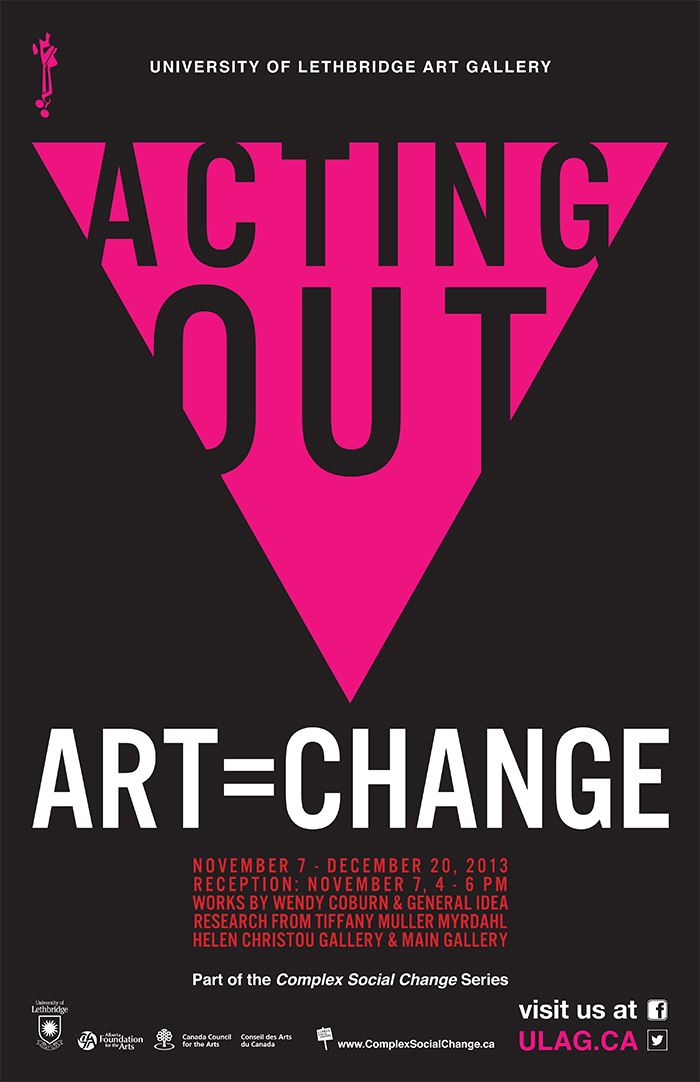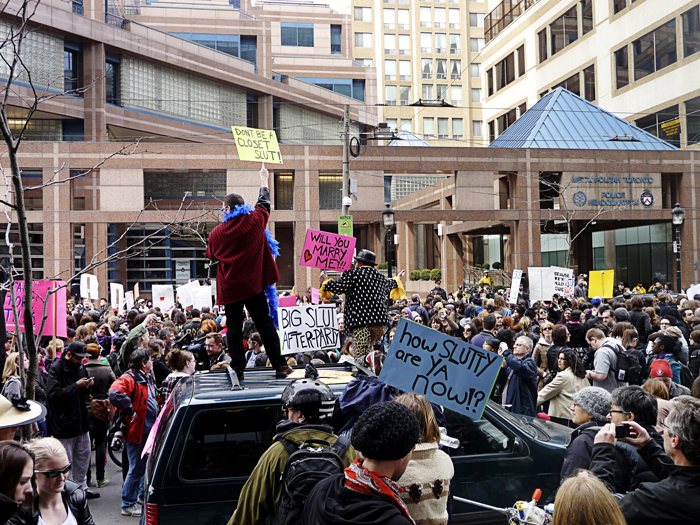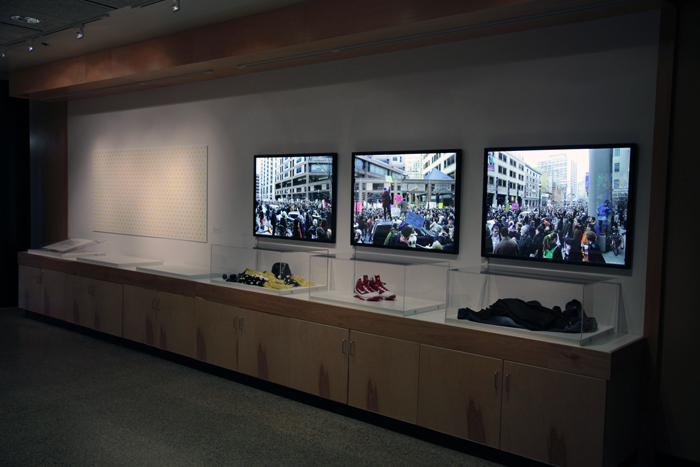Reception: November 7, 4 – 6 pm
Artist: Wendy Coburn
Wendy Coburn’s work here in the Helen Christou Gallery is part of the exhibition titled Acting Out. The exhibition continues in the Main Gallery (level 6, Centre for the Arts) with more work by Coburn as well as work by General Idea, videos by several artists, and a “reading room” which includes Tiffany Muller Myrdahl’s innovative approach to making her local LGBT oral history-social geography research visible. Acting Out is the first exhibition produced within Complex Social Change: teaching, performing, exhibiting, designing, mapping – an interdisciplinary research program and collaborative partnership involving Bruce MacKay, Louise Barrett, Lisa Doolittle, Emily Luce, Muller Myrdahl and myself. Complex Social Change includes a range of activities: connected research projects; exhibitions, performances, and video screenings; a Liberal Education course on activism; a website and social media posts; an activist theatre project; a series of panels and speakers; and a major publication for 2014. The series is supported with generous funding from the University of Lethbridge.
The inclusion of Wendy Coburn’s new body of work, “Anatomy of a Protest,” is the result of a serendipitous connection and timing. Coburn sent me an invitation for a studio visit right at the time that I was starting to research the exhibitions for the Complex Social Change series. Her contribution in the Main Gallery is more representative of the kind of art work she normally produces, but when I visited her studio, she decided to also show me the beginnings of this new project. It quickly became apparent that she was addressing precisely the kinds of issues that our research group hoped to explore. In particular, we wanted to investigate some of the larger issues surrounding complex social change, and investigate the means by which sustained, active engagement can be produced within particular communities, and resist the discursive, political, and economic pressures that encourage passive acceptance. With us both at the start of planning, we stayed in contact and had several conversation and visits that led to her creating this work specifically for the location of the Helen Christou Gallery and to be part of our research series.
“Anatomy of a Protest” provides a powerful exploration of questions of freedom of assembly and the state and media’s influence on social justice organizing and public expressions of dissent. Coburn’s attention to visual detail – recognizing the same distinctive sneakers or materials to create signs – combined with her painstaking research has created a remarkable analysis of the orchestrated performance of a team of provocateurs. Had this been a violent riot over a divided issue, one might be able to excuse the amount of human and financial resources that went into this performance by the provocateurs, but given the peaceful, good-natured, and clearly justified goals of the organizers of the march, such intervention can only be understood as part of the pressures that discourage activism and support passive acceptance of the status quo.
– Josephine Mills
Director/Curator
Artist Statement
There is a haunting echo in the banner slogans of two historic protests in Canada. “Enough Is Enough – Stop Police Violence” was the message on the lead banner of the protests against the police raids on gay bath-houses in Toronto in 1981. “Because We’ve Had Enough” was the slogan of the 2011 Slutwalk, a protest responding to statements made by a Toronto Police Constable to students at a safety and security panel at York University. The Constable’s statement; “women should avoid dressing like sluts in order not to be victimized”.
The fight-back attitude that characterized the bath-house raid protests and subsequent community organizing, was a catalyst for increased visibility, rights legislation and coalition-building across the country.
Local, small-scale and spontaneous, thirty years later the Slutwalk organizers pushed back, demanding reforms to police education and culture with a critique that cut through the blaming and shaming tactics aimed at silencing survivors of sexual assault, turning a steady eye on the perpetrators of sexual violence and the attitudes of our justice system. With its pro sex, anti-violence and anti-shaming stance, Slutwalk provided a much-needed critique that could be embraced by sex workers, queers, transgendered and feminist communities alike, inspiring countless satellite protests across the globe.
A chapter in the 1981 bath-house raids history book that is lesser known, is that of police provocateurs who infiltrated the protests. It was a reality I wouldn’t understand until the early nineties at the height of extreme-right organizing in Canada and the anti-racist actions in which so many of us became involved. With infiltrators, agitators, surveillance and counter-surveillance in action, many of us entered protests with a vigilant eye. Anticipating provocations, expecting bizarre theatrics and inflammatory placard slogans, we stood ready to respond.
The video, “Slut Nation: Anatomy of a Protest,” follows the movement of a group of protesters at that historic march and poses a series of questions related to freedom of assembly, our fundamental right to protest and express dissent, visual representations of protesters in the media, and whether our democratic rights are being undermined by those charged with our protection.
On the heels of the 2010 Toronto G20, and prior to the release of the Report of the Missing Women Commission of Inquiry in 2012, this body of work based on the 2011 Slutwalk, examines attitudes towards gender-based violence, bearing witness to the distance we have yet to travel for equality and justice.
– Wendy Coburn, October 2013








41 thoughts on “Acting Out
November 7 – December 20, 2013
Helen Christou Gallery | LINC | Level 9”